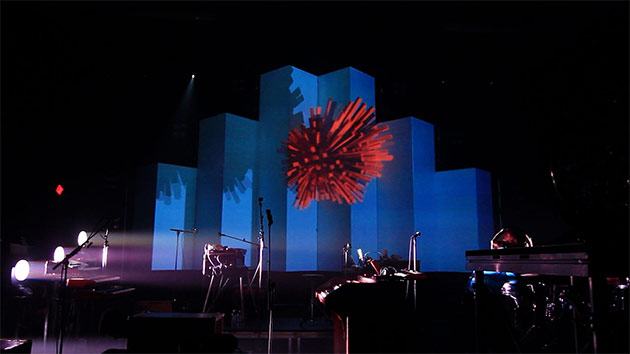Mapping Out the Video, Keeping it All Straight, and Selling the Illusion with Shadows
Time was the biggest challenge Rabbit Hole Creative faced when doing 3D content design, including projection mapping, and technical integration, for the six-pillar stage MuteMath used for their recent Odd Soul tour. Approached by Mutemath by way of 44 Production Designs, Rabbit Hole had just three weeks to get the job done before the show literally went on the road.
“We were even making content at rehearsals, but they loved what we were doing so it all turned out great,” recalls Jake Jorgovan, who co-founded the Nashville, Tennessee-based studio with Kevin Fulda. Using Maxon’s Cinema 4D, Rabbit Hole worked closely with the band, production designer Jeff Lava of 44 Production Designs and DWP Live to create a remarkable 3D experience.
To map video for the show Rabbit Hole projected content onto the structure and the band. Two projectors are used during this process so there is no overlap between the two images. To warp video onto the structure a template is put into the Pandora’s Box Media Server. “It’s the same concept as UV mapping, basically,” Scott says. “We just throw our videos in there and it lines up perfectly.”
Square pillars and a grid warp on the Pandora’s Box were intentionally used to make it easier to warp video into place. Independent set builder Clay Christian built the structure, which was designed so it could be folded up easily after each show.
Setting Up for Projection Mapping
Rabbit Hole Creative’s creative director Amanda Scott was the primary designer of the animations and 3D effects that were projected onto the structure during the show. All of the visuals were programmed to be in sync with the music the band was playing on stage. To test design ideas and animations, the Rabbit Hole team built a small-scale physical model of the six-pillared structure while Scott created a model of the stage in Cinema 4D.
By projecting the 3D model onto the 8-inch-tall foamboard structure, they could easily see if all of the lines were matching up correctly. Rabbit Hole does this for every projection-mapping project they do and it not only helps them, it helps clients understand what they’re trying to do visually. “It’s easy to break the illusion when you’re doing projection-mapping,” Scott explains. “Anything that doesn’t line up or goes off the sides of the structure won’t work, and it’s easy to see when we project it on a scale model.”
To find the sweet spot where everything lines up, Rabbit Hole figured out the vantage point from which most people would be viewing the structure and then set up the camera in C4D in that position. This process also determines where the projector will be placed in relationship to the real set. “It’s not that difficult. It just takes some time, but then I can be sure that if I’m building animations within the boundaries of the models they’ll work,” Scott adds.
Shadows are the key to making things look believable when using projection-mapping. And it’s those exaggerated shadows that create the 3D effect where it looks as if something on stage is actually moving out toward the audience. Scott uses both Cinema 4D and After Effects, but she prefers using C4D for projection-mapping projects because the shadows are more realistic. “Working in 3D is so much better because you have real-life shadows and I can make walls move believably,” she says. (See Rabbit Hole’s reel here: http://rabbitholecreative.com.)
Sticking to Abstraction
Mutemath gave Rabbit Hole a lot of creative freedom to come up with visuals for the tour. The one thing that they did ask was that the look was abstract; nothing was to be literal or illustrative of the lyrics. And drummer Darren King also contributed a couple of video segments he created himself using Final Cut Pro.
Scott played around with a lot of different looks while working on the abstract visuals for the band. Often, she was surprised to find how something that was simple to set up looked complicated once it was animated. She particularly likes the red sphere that appears to be pulsating out from the structure during the song “Quarantine”.
“I started with a cube and used a cloner object and a sound effector, but the shadows really made it work,” she says.
One afternoon, while sitting outside the sound studio where the band was rehearsing, Scott started experimenting with Robert Leger’s Voxel plugin (http://c4dtools.net/voxel-effect/) and came up with an effect that everyone liked immediately. “I’ve always wanted to try his plugin, so I downloaded it and just thought I’d use Mutemath’s stage to play around with,” she explains.
It was just a test, but when she pushed play the dynamics engine made the stage structure appear to crumble and fall to pieces. The band’s drummer happened to be walking by at the time and asked if they could use the effect in the show during the song “Collapse.” There wasn’t much time since the band was leaving on tour that night, but after working for three hours Scott had the animation ready to go. “It was a little rocky in some areas, but everyone was happy with it and I still wonder how I made that so fast.”
Meleah Maynard is a freelance writer and editor in Minneapolis, Minnesota.
Crafts: VFX/Animation
Sections: Creativity
Topics: Article Project/Case study cinema 4d projection mapping
Did you enjoy this article? Sign up to receive the StudioDaily Fix eletter containing the latest stories, including news, videos, interviews, reviews and more.



















Very inspiring article. I love the concept and execution looks amazing. Congrats.